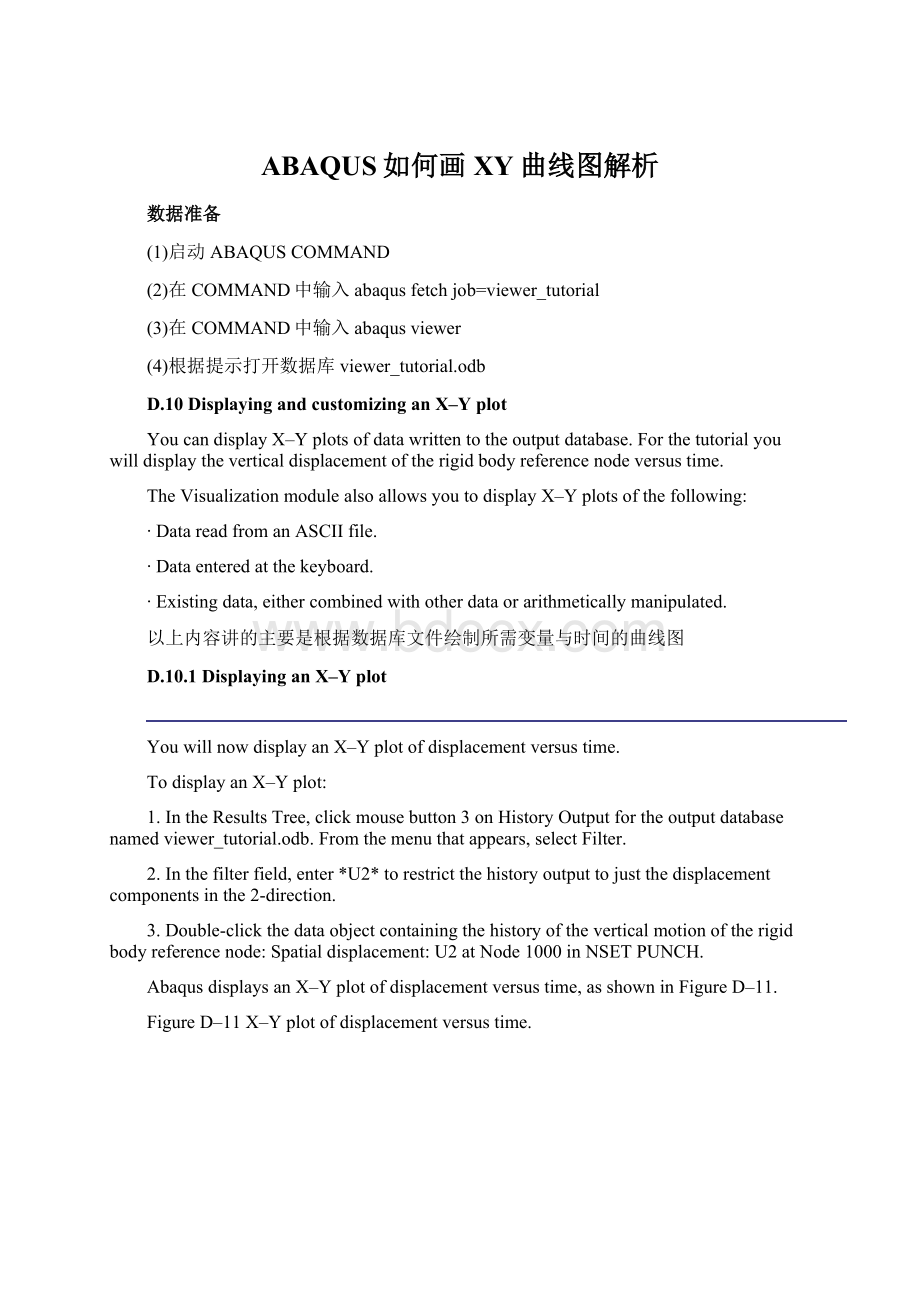ABAQUS如何画XY曲线图解析.docx
《ABAQUS如何画XY曲线图解析.docx》由会员分享,可在线阅读,更多相关《ABAQUS如何画XY曲线图解析.docx(17页珍藏版)》请在冰豆网上搜索。

ABAQUS如何画XY曲线图解析
数据准备
(1)启动ABAQUSCOMMAND
(2)在COMMAND中输入abaqusfetchjob=viewer_tutorial
(3)在COMMAND中输入abaqusviewer
(4)根据提示打开数据库viewer_tutorial.odb
D.10 DisplayingandcustomizinganX–Yplot
YoucandisplayX–Yplotsofdatawrittentotheoutputdatabase.Forthetutorialyouwilldisplaytheverticaldisplacementoftherigidbodyreferencenodeversustime.
TheVisualizationmodulealsoallowsyoutodisplayX–Yplotsofthefollowing:
∙DatareadfromanASCIIfile.
∙Dataenteredatthekeyboard.
∙Existingdata,eithercombinedwithotherdataorarithmeticallymanipulated.
以上内容讲的主要是根据数据库文件绘制所需变量与时间的曲线图
D.10.1 DisplayinganX–Yplot
YouwillnowdisplayanX–Yplotofdisplacementversustime.
TodisplayanX–Yplot:
1.IntheResultsTree,clickmousebutton3onHistoryOutputfortheoutputdatabasenamedviewer_tutorial.odb.Fromthemenuthatappears,selectFilter.
2.Inthefilterfield,enter*U2*torestrictthehistoryoutputtojustthedisplacementcomponentsinthe2-direction.
3.Double-clickthedataobjectcontainingthehistoryoftheverticalmotionoftherigidbodyreferencenode:
Spatialdisplacement:
U2atNode1000inNSETPUNCH.
AbaqusdisplaysanX–Yplotofdisplacementversustime,asshowninFigureD–11.
FigureD–11X–Yplotofdisplacementversustime.
DefaultoptionsselectedbyAbaqusincludedefaultrangesfortheX-andY-axes,axistitles,majorandminortickmarks,thecoloroftheline,andalegend.
4.ThelegendlabelstheX–YplotU2N:
1000NSETPUNCH.ThisisadefaultnameprovidedbyAbaqus.
以上操作如下图所示,如果输出变量列表中含有太多变量时,要找出我们想要的变量并不容易,这时就可以用输入”*U2*”表示2方向上的位移值,以去除列表中其余不必要的变量,便于选择,之后要把鼠标放在输出变量列表框里双击一下.接下来点击下面的”Plot”按钮就可以显示曲线了.
不过由以上操作过程可以看出,要显示这样的数据曲线,首先是需要我们在建模时就要要根据需要设置相应的节点集合和单元集合.比如这个数据库文件中就有下图所示的节点集和单元集.要不然就没法画这样的曲线图了.
D.10.2 CustomizinganX–Yplot
Bydefault,AbaquscomputestherangeoftheX-andY-axesfromtheminimumandmaximumvaluesfoundinthedatareadfromtheoutputdatabase.Abaqusdivideseachaxisintointervalsanddisplaystheappropriatemajorandminortickmarks.TheAxisOptionsallowyoutosettherangeofeachaxisandtocustomizetheappearanceoftheaxes;theCurveOptionsallowyoutocustomizetheappearanceoftheindividualcurves;theChartOptionsandChartLegendOptionsallowyoutopositionthegridandlegend,respectively.X–Yplotcustomizationoptionsapplyonlytothecurrentviewportandarenotsavedbetweensessions.
(这部分讲的主要是对曲线图进行相关的操作,这些操作主要包括:
设置坐标轴的名称,单位;调整图域的大小;设置刻度线的长度,数量;是否显示栅格,是否有标题栏.自已摸索一下就OK了,也可以跳过不看)
TocustomizeanX–Yplot:
1.Fromthemainmenubar,selectOptions
XYOptions
Axis(orclick
inthepromptareatocancelthecurrentprocedure,ifnecessary,anddouble-clickeitheraxisintheviewport).
AbaqusdisplaystheAxisOptionsdialogbox.
2.SwitchtotheScaletabbedpage,ifitisnotalreadyselected.
3.SpecifythattheX-axisshouldextendfrom0(theX-axisminimum)to20(theX-axismaximum)andthattheY-axisshouldextendfrom–200(theY-axisminimum)to0(theY-axismaximum).
Tip:
SelecteachaxisinturnintheAxisOptionsdialogbox,andtheneditthescaleasnotedabove.
4.FromtheoptionsintheAxisOptionsdialogbox,dothefollowing.
∙IntheScaletabbedpage,requestthatmajortickmarksappearontheX-axisatfour-secondincrements(selectByincrementintheTickModeregionofthepage).
∙Request3minortickmarksperincrementalongtheX-axis(thiscorrespondstoaminortickmarkeverysecond)and4minortickmarksperincrementalongtheY-axis(thiscorrespondstoaminortickmarkevery10mm).
∙IntheTitletabbedpage,typeaY-axistitleofDisplacementU2(mm).
∙IntheAxestabbedpage,requestaDecimalformatwithzerodecimalplacesfortheY-axislabels.
5.ClickDismisstoclosetheAxisOptionsdialogbox.
前面几步主要是设置坐标轴,可按下图操作,主要就是弄明白四个属性页的意思就可以了,SCALE是调整坐标和显示比例的,TrikMarks是用来调整刻度线的长度,线型,数量的.Title是用来设置坐档轴的名称,单位的.Axis是用来设置曲线的线型颜色的.
6.Fromthemainmenubar,selectOptions
XYOptions
Chart(ordouble-clickanyemptyspotintheplot)tomodifythegridlinesandpositionthegrid.
∙IntheChartOptionsdialogboxthatappears,switchtotheGridDisplaytabbedpage.
∙ToggleonMajorinboththeXGridLinesandYGridLinesfields.Changethecolorofthemajorgridlinestoblue;thelinestyleshouldbesolid.
∙SwitchtotheGridAreatabbedpage.
∙IntheSizeregionofthispage,selecttheSquareoption.
∙Usetheslidertosetthesizeto75.
∙InthePositionregionofthispage,selecttheAuto-alignoption.
∙Fromtheavailablealignmentoptions,selectthefourthtolastone(positionthegridinthebottom-centeroftheviewport).
∙ClickDismiss.
以上说了这么多也同什么,就是用来调整图弄的显示区域的大小了,总共就二个属性页,很了看的)
7.Fromthemainmenubar,selectOptions
XYOptions
ChartLegend(ordouble-clickthelegend)topositionthelegend.
a.IntheChartLegendOptionsdialogbox,switchtotheAreatabbedpage.
b.InthePositionregionofthispage,toggleonInsetandclickDismiss.
c.Dragthelegendintheviewporttorepositionit.
ThecustomizedX–Yplotappears,asshowninFigureD–12.
这里说的主要就是用来加曲线图中左上角的那个小方框了,把ARAE属性页上的Insert旁的小方框勾上就OK了.
FigureD–12CustomizedX–Yplotofdisplacement.
8.YouwillnowdisplayasecondX–Yplotinanewviewport.Tocreateanewviewport,selectViewport
Createfromthemainmenubar.
Thenewviewportappears.ThesameX–Yplotthatyouhadinthefirstviewportappearsinthenewviewport.
Whenmultipleviewportsarevisible,thedarkgraytitlebarindicatesthecurrentviewport;allworktakesplaceinthecurrentviewport.Formoreinformation,see“Whatisaviewport?
”Section4.1.1oftheAbaqus/CAEUser'sManual.
9.TiletheviewportsverticallybyselectingViewport
TileVerticallyfromthemainmenubar.
10.CreateasimilarX–Yplotofverticalvelocity(V2)versustime.Youcannotselectvelocityduringthefirststepbecausethefirststepwasnotadynamicstep;Abaqus/Standardcomputedvelocityandaccelerationonlyduringthesecondandthirdsteps.UsethesameX-axisrangeasbefore,anduseaY-axisrangefrom1000to–1000.LabeltheY-axisVelocityV2.ThefinishedplotisshowninFigureD–13.
上边说的意思就是说告诉我们如何建立多个视窗显示多条曲线了.可按下图操作
FigureD–13CustomizedX–Yplotofvelocity.
D.11 OperatingonX–Ydata
AnX–YdataobjectisacollectionoforderedpairsthatAbaqusstoresintwocolumns—anX-columnandaY-column.TheOperateonXYDatadialogboxallowsyoutocreatenewX–YdataobjectsbyperformingoperationsonpreviouslysavedX–Ydataobjects.Inthistutorialyouwillcreateastressversusstraindataobjectbycombiningastressversustimedataobjectwithastrainversustimedataobject.Then,youwillplotthestress-straincurve..
这部分讲的就是教我们如何画应力应变曲线了,可以好好看看
D.11.1 Creatingthestressversustimeandstrainversustimedataobjects
Thefirststepincreatingthestress-straincurveistocreatethestressversustimeandthestrainversustimedataobjectsfromthehistoryoutput.Thedataobjectswillcontaindatafromonlythefirststepoftheanalysis,wherethepunchrestsonthesurfaceofthefoamblockandcompressestheblockunderitsownweight.
先建立两条数据曲线,一条是应力-时间曲线,一条是应变-时间曲线
TocreatetheX–Ydataobjects:
1.IntheResultsTree,double-clicktheXYDatacontainer.
TheCreateXYDatadialogboxappears.
2.Inthisdialogbox,selectODBhistoryoutputifitisnotalreadyselectedandclickContinue.
TheHistoryOutputdialogboxappears.
3.IntheHistoryOutputdialogbox,dothefollowing:
a.ClicktheVariablestab.
b.IntheOutputVariablesfield,selectLogarithmicstraincomponents:
LE22atElement1IntPoint1inELSETCENT.
c.ClicktheSteps/Framestab.
d.SelectStep1.
e.ClickSaveAs.
TheSaveXYDataAsdialogboxappears.
f.NametheX–YdataStrain,andclickOK.
AdataobjectcalledStraincontaininglogarithmicstraindata(LE22)fromintegrationpoint1ofelement1duringthefirststepoftheanalysisappearsintheXYDatacontainer.
这三步就是进如何建立应变-时间曲线图的,双击一下下图文件树中的阴影部分就会弹出”CreateXYData”对话框了接下来就可以选择相应的单元,画出该单元对应的应变-时间曲线了,如果相要的单元不好找就可以按上面的方法输入一个变量进行筛选了.
要注意的是,在有限元分析中,只有单元才存在应变-时间,应力-时间曲线的,节点是不存这样的曲线的.
4.Useasimilartechniquetocreateadataobjectcontainingstressdata(S22)fromintegrationpoint1ofelement1duringthefirststepoftheanalysis.NamethisdataobjectStress.
Tip:
Filterthevariablelistaccordingto*S22*.
Nowyouarereadytocombinethetwodataobjectstocreateastressversusstraindataobject.
5.DismisstheHistoryOutputdialogbox.
D.11.2 Combiningthedataobjects
Inthissectionyouwillcreateastressversusstraindataobjectbycombiningthestressversustimeandstrainversustimedataobjects.
Tocombinethedataobjects:
1.IntheResultsTree,double-clicktheXYDatacontainer.
2.FromtheCreateXYDatadialogboxthatappears,selectOperateonXYdataandclickContinue.
AnOperateonXYDatadialogboxappears.Thedialogboxcontainsthefollowinglists:
∙TheXYDatafieldontheleftcontainsalistofexistingX–Ydataobjects.
∙TheOperatorsfieldontherightcontainsalistofallthepossibleoperationsyoucanperformonthedataobjects.
3.FromtheOperatorsfield,clickcombine(X,X).
combine()appearsintheexpressiontextfieldatthetopofthedialogbox.
4.IntheXYDatafield,dragthecursoracrossboththeStrainandtheStressdataobjectstoselectbothandclickAddtoExpressionnearthebottomofthedialogbox.
Theexpressioncombine("Strain","Stress")appearsintheexpressiontextfield.Inthisexpression"Strain"willdeterminetheX-valuesand"Stress"willdeterminetheY-valuesinthecombinedplot.
5.FromthebuttonsalongthebottomoftheOperateonXYDatadialogbox,clickSaveAs.
6.Fromt